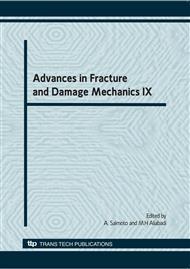p.185
p.189
p.193
p.197
p.201
p.205
p.209
p.213
p.217
Comparison between Fatigue Life of Autofrettage and Nonautofrettage Cylinders Using Stress Intensity Factor (KΙ)
Abstract:
This paper provides approximate fatigue life estimates for aluminum cylinders with a constant ratio of outer to inner radii 2.2 which were subjected to autofrettage pressure. Experimental tests of cylinders made of aluminum alloy are part of this article. Numerical simulations of the cylinders were also performed using the finite element code, ABAQUS. The resulting stresses are then used to calculate stress intensity factors to determine fatigue life. Using standard fatigue crack growth relationship, life of the cylinder is then calculated based on recommended initial and final crack length. The results show that the fatigue life due to autofrettage is more than nonautofrettage cylinder between Py1 and Py2 where, Py1 is the pressure required at the onset of yielding which occurs at the inner surface of the cylinder and Py2 is the sufficient pressure to bring the outer surface of the cylinder to yielding, i.e. the wall of cylinder becomes fully plastic.
Info:
Periodical:
Pages:
201-204
Citation:
Online since:
November 2010
Authors:
Keywords:
Price:
Сopyright:
© 2011 Trans Tech Publications Ltd. All Rights Reserved
Share:
Citation:


